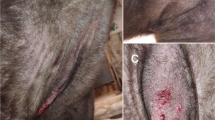Abstract
Cutaneous lesions in human patient due to the bite of rat mite Ornithonyssus bacoti are frequently misdiagnosed as allergies, fungal infection, or bacterial infection. Bite lesions in the personnel working in a Laboratory Animal facility which was infested with O. bacoti is reported here along with its therapeutic management. Diagnosis of the parasites obtained from the clothing of the personnel and later from the infested mice colony was based on preliminary light microscopy and confirmed by scanning electron microscopy. The mean length and breadth of adult female mite were 1.13 mm × 0.63 mm. The body is hairy, unsegmented and has four pairs of legs. The gnathostoma has long pointed chelicerae and pedipalp. The dorsal surface has one dorsal shield, and the ventral surface has three shields- sternal, genital and anal shield. Treatment of dermatitis involved antihistaminic drugs for a period of 3–5 days. The skin lesion, characterized by papular erythema, tends to disappear within a period of 4–5 days of antihistaminic treatment. In untreated cases, the lesions disappeared within 7–10 days. Tropical rat mite O. bacoti Hirst, 1931 was identified to be the cause of infestation in the laboratory mice colony of Pasteur Institute of India, Coonoor, Tamil Nadu, predisposing the animal handlers to be temporary host.




Similar content being viewed by others
References
Baker DG (1998) Natural pathogens of laboratory mice, rat, and rabbits and their effects on research. Clin Microbiol Rev 11:231–266
Beck W (2007) Tropical rat mites as newly emerging disease pathogen in rodents and man. J. Travel Med Infect Dis 6(5):403
Beck W (2008) Occurrence of a house- infesting tropical rat mite (Ornithonyssus bacoti) on murides and human being. Travel Med Infect Dis 6:245–249
Beck W, Fölster-Holst R (2009) Tropical rat mite (Ornithonyssus bacoti)-serious ectoparasites. Journal der Deutschen Dermatologischen Gesellschaft 7(8):667–670
Beck W, Pfister K (2006) Humanpathogene Milben als Zoonoseerreger. Wien Klin Wochenschr 118(19-20 suppl 3):27–32
Cole JS, Sabol-Jones M, Karolewski B, Byford T (2005) Ornythonyssus bacoti infestation and elimination from a mouse colony. Contemp Top Lab Anim Sci 44(5):27–30
Dey S (1993) A new rapid air drying technique for scanning electron microscope using tetramethyl silane : application to mammalian tissues. Cytobios 73(292):17–23
Engel PM, Welzel J, Maass M, Schramm U, Wolff HH (1998) Tropical rat mite dermatitis: case report and review. Clin Infect Dis 27:1465–1469
Fishman HC (1988) Rat mite dermatitis. Cutis 42:414–416
Hetherington GW, Holder WR, Smith ED (1971) Rat mite dermatitis. JAMA 215:1499–1500
Hill WA, Randolph MM, Boyd KL, Mandrell TD (2005) Use of permethrin eradicated the tropical rat mite (Ornithonyssus bacoti) from a colony of mutagenized and transgenic mice. Contemp Top Lab Anim Sci 44(5):31–34
Nath AJ, Venkataramana KN, Fölster-Holst R, Beck W (2013) Epizootiology, treatment and control of tropical rat- mite infestation in a breeding colony of Swiss mice under temperate climate of Nilgiris Hill- India. Anim Sci Rep 7(3):114–120
Reeves W, Loftis A, Szumlas DE et al (2007) Rickettsial pathogens in the tropical rat mite Ornithonyssus bacoti (Acari: Macronyssidae) from Egyptian rats (Rattus spp). Exp Appl Acarol 41:101–107
Scharf MJ, Daly JS (2003) Bites and stings of terrestrial and aquatic life. In: Freedberg IM, Eisen AZ, Wolff K, Austen KF, Goldsmith LA, Katz SI (eds) Fitzpatrick’s dermatology in general medicine. McGraw- Hill, New York, pp 2261–2298
Soulsby EJL (1982) Order: Acarina, Nipzch, 1818, Suborder: Mesostigmata, Canestrini, 1891. In: Soulsby EJL (ed) Helminths, arthropods and protozoa of domesticated animals, 7th edn. ELBS, and Bailliere Tindal, London, pp 446–452
Steen CJ, Carbonaro PA, Schwartz RA (2004) Arthropods in dermatology. J Am Acad Dermatol 50(6):819–842
Tika Ram SM, Satija KC, Kaushik RK (1986) Ornithonyssus bacoti infestation in laboratory personnel and veterinary students. Int J Zoonoses 13(2):138–140
Watson J (2008) New Building, old parasite: Mesostigmatid mites—an ever present threat to barrier rodent facilities. ILAR J 49(3):303–309
Acknowledgments
The authors are thankful to the Director, Pasteur Institute of India, Coonoor, Tamilnadu, 643103, and the Dean, College of Veterinary Science, Assam Agricultural University, Khanapara, Guwahati, Assam, 781 022 for providing the facilities to carry out the study. Dr S. Dey, Scientific Officer, Sophisticated Analytical Instrument Facility, North Eastern Hill University, Shillong-22, Meghalaya is also duly acknowledged for his help in SEM works.
Author information
Authors and Affiliations
Corresponding author
Rights and permissions
About this article
Cite this article
Nath, A.J., Islam, S. & Sahu, S. Use of scanning electron microscopy to confirm the identity of tropical rat mite (Ornithonyssus bacoti): the cause of rat mite dermatitis. J Parasit Dis 40, 161–165 (2016). https://doi.org/10.1007/s12639-014-0469-8
Received:
Accepted:
Published:
Issue Date:
DOI: https://doi.org/10.1007/s12639-014-0469-8




